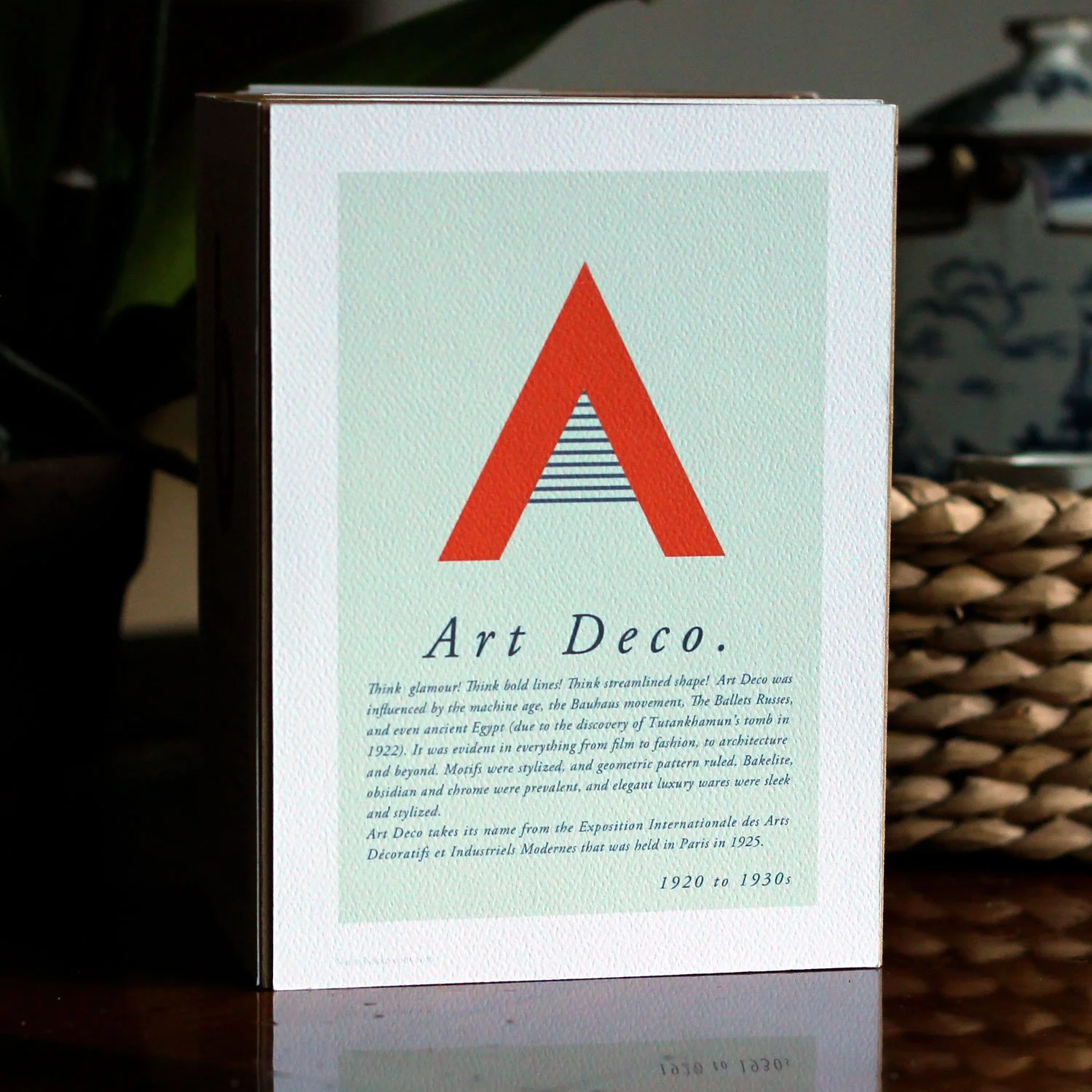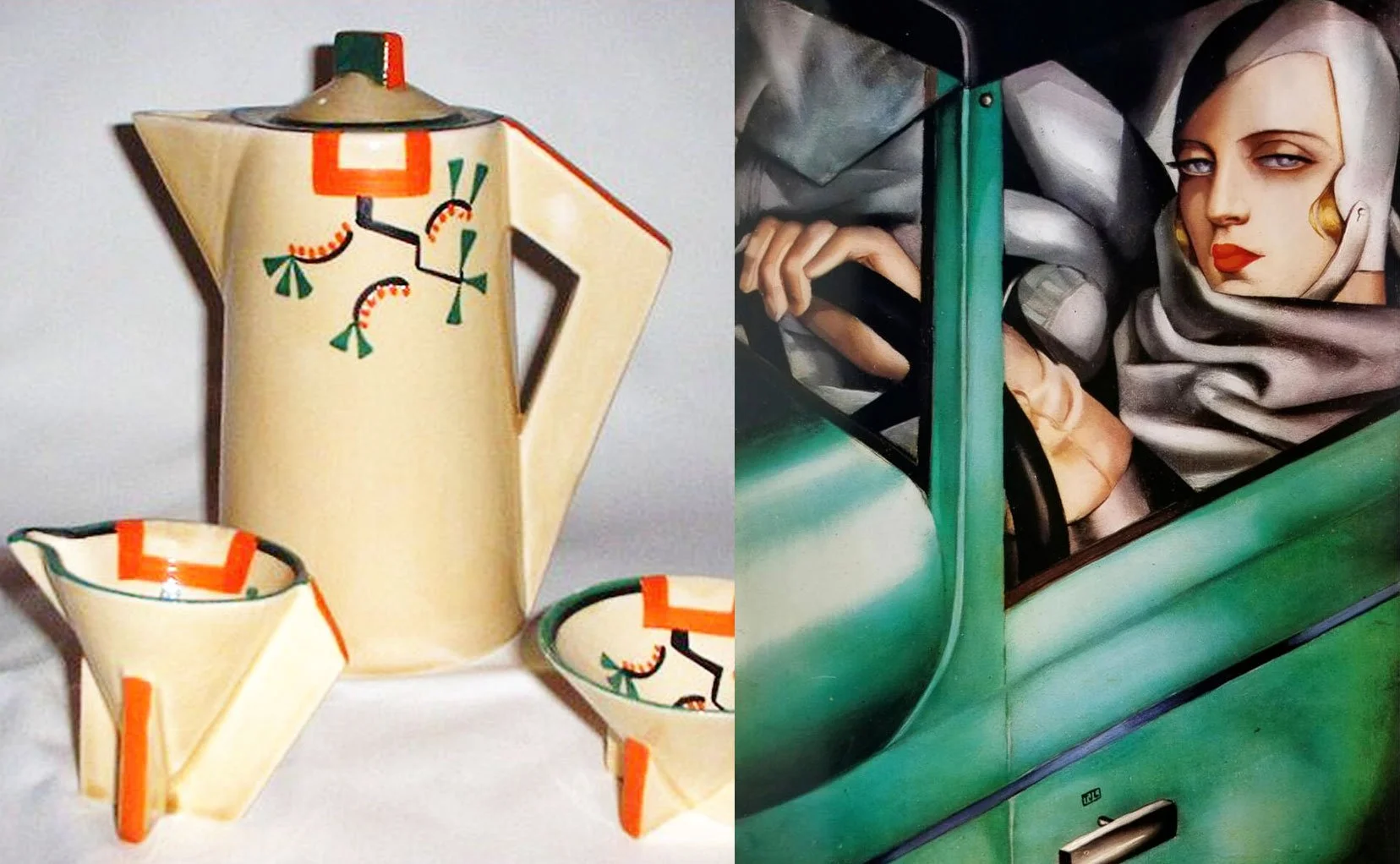All About Art Deco
The Art Deco Era: Glamour, Geometry, and the Machine Age
Think glamour! Think bold lines! Think streamlined shape! Art Deco was influenced by the machine age, Travel, The Ballets Russes, and even ancient Egypt (due to the discovery of Tutankhamun’s tomb in 1922).
It was evident in everything from film to fashion, to architecture and beyond. Motifs were stylized, and geometric pattern ruled. Bakelite, obsidian and chrome were prevalent, and elegant luxury wares were sleek and stylized.
Art Deco takes its name from the Exposition Internationale des Arts Décoratifs et Industriels Modernes that was held in Paris in 1925.
Dress by Erté, fashion plate with typical elongated styles.
Dates: c. 1919–1939
Mood: Sleek, luxurious, modern, cosmopolitan
Palette: Black and gold, silver and chrome, ivory, jade green, lacquer red, deep blue, orange
Key Figures: Émile-Jacques Ruhlmann (furniture and interiors), Jean Dunand (artist and designer) Clarice Cliff (ceramics), Donald Deskey (industrial design), Erté (fashion and illustration), Tamara de Lempicka (art), Eileen Gray (furniture), Renee Lalique (glass), Paul Poiret (fashion)
Key Characteristics
Chevron, Zig-Zag patterns, skyscrapers like the Chrysler Building
Cruise Ships, Airplanes, Cars and Trains and advertising posters that spoke to glamour
‘Waterfall’ furniture with rounded, stepped, tier silhouettes
Slender fashion silhouettes
Ancient Egyptian motifs (due to the discover of King Tut’s tomb in 1922)
Bakelite, Lucite, Celluloid plastics
Chrome Steel, glass, mirrors
Luxury accessories such as cocktail shakers, cigarette cases, jewelry
Lacquer screen by Eileen Gray (right), architect and designer from the Deco and Modernist age.
Modern Elegance for a New Age
Born in the wake of World War I and named after the 1925 Exposition Internationale des Arts Décoratifs et Industriels Modernes in Paris, Art Deco defined the optimism and sophistication of the interwar years. It fused craftsmanship with modernity — geometry with glamour — creating a style that celebrated progress, speed, and luxury in equal measure.
The Chrysler Building to the left and a decorative capital showing warrior face done in stylized deco design.
Architecture and Design
Art Deco architecture was bold, symmetrical, and stylized. In place of the ornate scrolls of the past came zigzags, chevrons, sunbursts, and stepped forms inspired by skyscrapers and machinery. Buildings like the Chrysler Building and Radio City Music Hall in New York turned steel and stone into sculpted light, while French architects like Auguste Perret explored the elegance of concrete and proportion.
Iconic decorative metalwork in ‘Gatsby’ style.
Interiors were sleek and theatrical: mirrored walls, inlaid woods, polished chrome, and glossy lacquer reflected the shimmer of the modern city. Marble floors, etched glass, and streamlined silhouettes created a visual rhythm both dynamic and composed.
French Deco ‘Chariot’ side chest by Émile-Jacques Ruhlmann. Created in macassar ebony with ivory inlay.
Furniture and Decorative Arts
Art Deco furniture celebrated craftsmanship and exotic materials — macassar ebony, rosewood, ivory, chrome, shagreen, and mother-of-pearl. French designers such as Émile-Jacques Ruhlmann and Eileen Gray produced pieces that balanced opulence with restraint, while in Britain and America, designers combined luxury veneers with industrial forms.
Clarice Cliff coffee set and painting by Tamara de Lempicka, ‘Tamara in a Green Bugatti’
The decorative arts flourished: Lalique glass, Clarice Cliff ceramics, and Bakelite jewelry captured the glamour of the age in every medium. Pattern was geometric, sometimes Egyptian or Aztec-inspired, reflecting the fascination with archaeology and travel that defined the 1920s and ’30s.
Art Deco color palette
Color and Mood
The Art Deco palette shimmered with contrast — black and gold, jade and ivory, coral and chrome. It was theatrical and urbane, equally suited to the cinema palace and the ocean liner. Lighting — in frosted glass, tiered sconces, and chrome fixtures — became a design feature in its own right, casting a silver glow over every surface.
Final Notes…
Art Deco defined the look of the modern age — where luxury met industry, and beauty became speed. It remains timeless because it captured the essence of its era: confidence, precision, and glamour. Today, every polished curve and geometric glint still speaks of a world dreaming in chrome and champagne.








